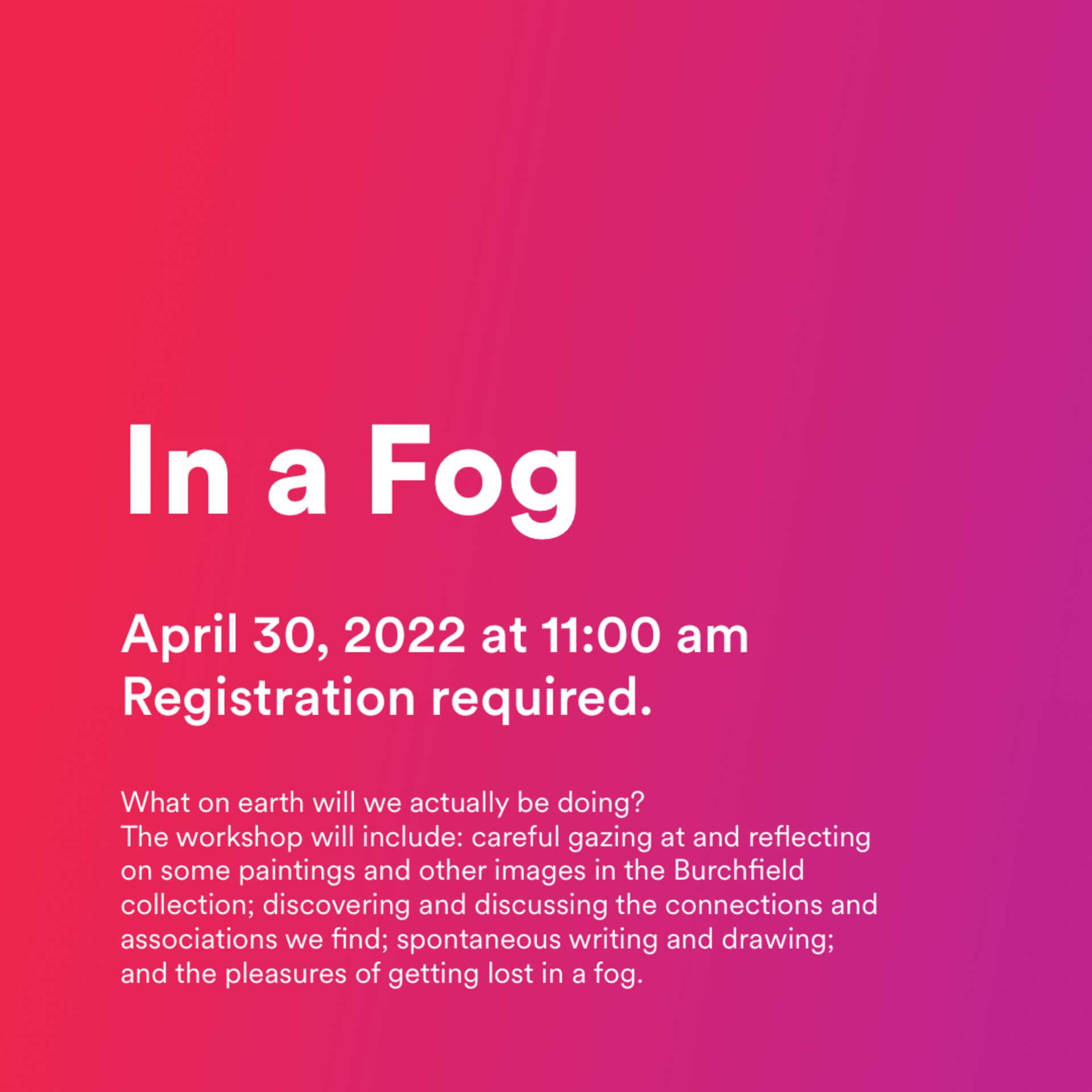
In a Fog
Part of the Reworking Sense Series
Apr 30, 2022 11:00am — 1:00pm
$24 members/$34 Not-yet members
In-person at the Burchfield Penney Art Center
It’s a poor sort of memory that only works backward. —Alice in Wonderland

Charles E. Burchfield (1893-1967), Street Vista in Winter, 1957-60, watercolor on paper, 26 1/4 x 43 3/4 inches
Turning down an unfamiliar street one night, the world enveloped in fog, you pause. The air is still, but the mist swirls around you, obscuring and revealing the hazy shapes of things past, or perhaps things yet to come. In the distance, just out of sight, a train bellows through the impassive night, echoing from behind the veil of some long-forgotten sorrow. Suddenly you are overtaken by a feeling of intense familiarity: you have been here before. You have stood right here, in this exact moment, on this dark and mysterious street, its trees shuddering with mystery, the streetlights hiding more than they show. Is it a memory, or a dream? Is it real, or imagined? Are you experiencing a split second of time travel, or is the fog that surrounds you seeping into your very thoughts on some kind of quantum level? Do you have the foggiest idea?
In fact, this is all happening while you are standing in a gallery, gazing into a painting of a dark and fog-bound street. And yet you feel the clamminess of the mist on your cheek; you hear the train calling and recalling you to some murky place inside your heart; you see phantoms forming and dissolving in the dense fog. You are outside and inside the painting at the same time; you are outside and inside time itself; you are immersed in reverie. You are in a fog.
Please join us for collaborative exploration of human memory and its correspondences, manifestations, representations, and associations among our senses and within art. Nesting deep within the primeval thickets of emotion, pain, dream, and metaphor, memory and its twin—forgetting—calls out from the past to describe the present or imagine the future.
Our hope is that immersing ourselves in an investigation of the physical, embodied experience of fog may illuminate, through the intuitive power of metaphor and the creative experiments of art, some of what we cannot grasp about the shadowy workings of our memory.
This somewhat foggy introduction to our workshop may leave you wondering: what on earth will we actually be doing? The workshop will include: careful gazing at and reflecting on some paintings and other images in the Burchfield collection; discovering and discussing the connections and associations we find; spontaneous writing and drawing; and a very tiny bit of learning about the intersections of the human mind and body with art, emotion, creativity, neuroscience, and the pleasures of getting lost in a fog.
Sessions will reference artworks in the Burchfield Penney Art Center galleries.
Participants:
Participants are encouraged to bring a sketchbook/journal and a pencil (no pens) to the sessions.
Registration Form: Please fill form and email to shirokkg@buffalostate.edu
For further information about the series contact Kathy G. Shiroki at shirokkg@buffalostate.edu or 716.878.3549.
Innovative Team: Eli Finnegan, Julie Kirsch, Carolyn Korsmeyer, Phyllis Thompson
Eli Finnegan
Eli Finnegan is a filmmaker, writer, and mixed-media artist whose work has been exhibited in the U.S. and internationally and has won awards at festivals in the U.S., Canada, and Europe. She is an Associate Professor of English at D’Youville College, where she teaches courses in literature, film and media studies, visual studies, creative writing, and consciousness studies. Eli has published articles and book chapters on film, literature, and television; her scholarship explores questions of knowledge and representation, and the intersections of language, body, image, and ethics. Her films and writing combine narrative, experimental, and documentary forms to tell stories that seek to expand what narrative is and does. Currently, she is working on a novel based loosely on Aeschylus’s Oresteia.
Dr. Julie Kirsch
Julie Kirsch is a professor of philosophy at D’Youville College in Buffalo, NY. Her current research focuses upon self-knowledge and the ethics of belief and memory. She became interested in these problems after investigating the nature and ethics of self-deception in her earlier work. She recently co-edited (with Patrizia Pedrini) a collection of essays on self-knowledge, entitled Third-Person Self-Knowledge, Self-Interpretation, and Narrative (2018). Included in the volume is her own essay, “Interpreting Things Past (2018),” which looks at the role that interpretation plays in the way that we remember past events. Other publications include “Self-Deception and Moral Epiphany in Flannery O’Connor” (2020), “Interpreting Our Emotions,” (2019), “Narrative and Self-Deception in La Symphonie Pastorale” (2012), “When Is Ignorance Morally Objectionable?” (2011), and “Maladies of Fantasy and Depth” (2009).
Dr. Kirsch teaches a broad range of courses at D’Youville, including Bioethics, Mysteries of the Mind, Philosophy of Art, History of Modern Philosophy I, and Knowledge and Reality. She also organizes local events for B-WIP (Buffalo Women in Philosophy), a group that she co-founded with Dr. Kimberly Blessing from Buffalo State College. In addition to her work in philosophy, she is a visual artist and explores philosophical themes, particularly those surrounding the mind and cognition, in her drawings and paintings.
Carolyn Korsmeyer
Carolyn Korsmeyer is a philosopher and (more recently) a novelist. She writes in the field of aesthetics and is especially interested these days in the ways that emotions, memory, and the senses are engaged by works of art. These topics are explored in her books Making Sense of Taste: Food and Philosophy and Savoring Disgust, both of which consider the senses of taste and smell. The role of touch in aesthetic encounters is examined in Things: In Touch with the Past. For more details, see her website: www.carolynkorsmeyer.com.